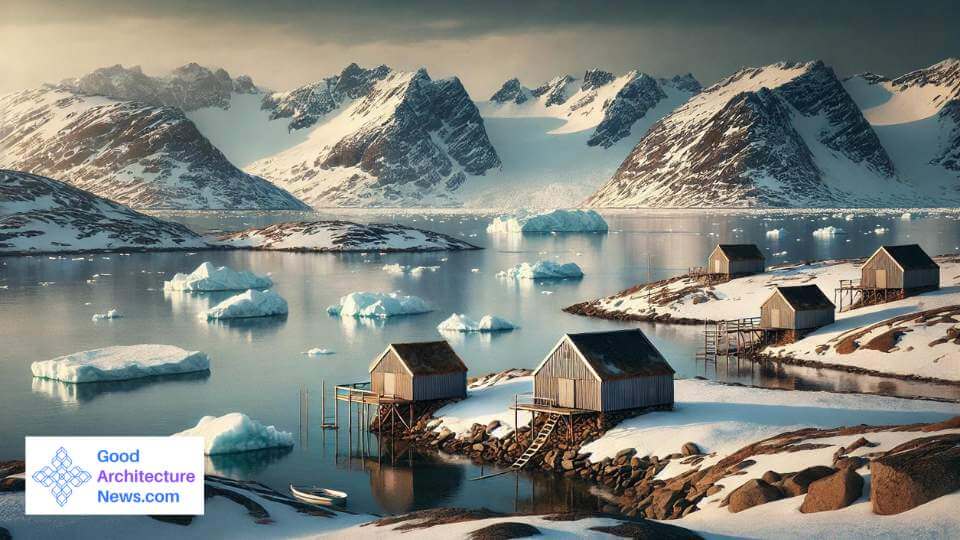Architecture in Greenland: Blending Tradition, Modernity, and the Arctic Landscape
Greenland, with its vast icy expanse and small population, offers a unique architectural landscape shaped by its extreme climate, indigenous culture, and colonial history. Architecture in Greenland is more than just a response to the cold—it reflects a blend of adaptation to the environment, cultural heritage, and the influence of modern design. As the country continues to urbanize and face the challenges of climate change, architecture in Greenland is evolving, yet remains deeply connected to its roots. This long-form blog delves into the architectural journey of Greenland, from traditional Inuit structures to cutting-edge sustainable buildings.
Traditional Architecture: Surviving the Arctic Climate
Greenland’s indigenous architecture was born out of necessity. The Inuit people, who have lived in Greenland for centuries, developed structures that allowed them to survive in one of the harshest climates on Earth. These traditional buildings were simple yet incredibly effective at providing warmth and shelter.
1. Turf Houses: Earth’s Insulation
One of the most iconic forms of traditional Greenlandic architecture is the turf house. These houses, known locally as “peqipanik,” were primarily built by early Inuit communities. Turf houses were constructed using stones, driftwood, and layers of turf, with walls sometimes as thick as three feet. The design provided excellent insulation against the cold Arctic winds, and the houses were often built partially underground to retain heat.
Turf houses were typically dark inside, with small windows or openings for light, but they offered warmth and protection from the elements. These homes were communal, with several families often living together in a single structure. Today, remnants of turf houses can still be seen in Greenland’s more rural areas, offering a glimpse into the past and how the Inuit people ingeniously adapted to their environment.
2. Inuit Summer Tents and Igloos: Seasonal Mobility
In addition to turf houses, the Inuit used more temporary structures, such as summer tents and igloos. During the warmer months, the Inuit would set up tents made from animal skins stretched over a framework of bones or driftwood. These tents were easy to dismantle and transport, reflecting the nomadic lifestyle of the Inuit as they followed hunting and fishing patterns.
Igloos, though less common in Greenland today, were used during the winter months, primarily by Inuit hunters. Made from blocks of compacted snow, igloos provided surprising warmth, with the interior temperature often reaching above freezing even when it was far below zero outside. These ingenious structures were not only a symbol of survival but also of the Inuit’s intimate knowledge of their surroundings.
Danish Colonial Influence: Colorful Wooden Houses
In the 18th century, Greenland became a Danish colony, and with this came the introduction of European-style architecture. The most visible remnants of this period are the brightly colored wooden houses scattered across Greenland’s towns and cities.
1. Nuuk’s Colonial Buildings
Greenland’s capital, Nuuk, features many examples of Danish colonial architecture, especially in the older parts of the city. The wooden houses, painted in vibrant colors such as red, blue, yellow, and green, contrast sharply with the stark Arctic landscape, creating a visually striking scene. These colors were initially used to designate the function of the buildings—red for commercial buildings, blue for hospitals, yellow for police stations, and so on. Over time, this tradition became more decorative than functional, but the colorful homes have become an iconic part of Greenlandic towns.
2. Lutheran Churches
The introduction of Danish colonialism also brought Lutheran Christianity to Greenland, and with it, European-style churches. These wooden churches, such as the famous Hans Egede Church in Nuuk, are some of the most prominent buildings in Greenlandic towns. Many of these churches are simple in design, with steeply pitched roofs to prevent snow accumulation, but they hold cultural and historical significance for the communities that built them.
Modern Architecture in Greenland: Adapting to New Challenges
As Greenland continues to urbanize, modern architecture is increasingly becoming part of the landscape. The country’s largest city, Nuuk, is at the forefront of this architectural transformation, with a blend of traditional designs and contemporary innovations.
1. The Katuaq Cultural Centre: Northern Lights in Design
One of the most iconic modern buildings in Greenland is the Katuaq Cultural Centre, located in Nuuk. Designed by Danish architects Schmidt Hammer Lassen, the building’s undulating wooden façade was inspired by the natural elements of Greenland—the waving Northern Lights, the ice, and the mountains. Inside, Katuaq houses a cinema, concert hall, and exhibition spaces, making it a hub of cultural activity.
The use of local materials, combined with a design that reflects Greenland’s natural beauty, makes Katuaq an excellent example of modern Greenlandic architecture that respects its surroundings. It also demonstrates how modern architecture in Greenland is moving toward more cultural and environmental integration, rather than simply importing European designs.
2. Sustainable Architecture and Climate Change
Greenland’s modern architects face unique challenges due to climate change. The melting of the permafrost, rising sea levels, and unpredictable weather patterns require innovative approaches to building design. As a result, sustainable architecture is becoming increasingly important in Greenland, with architects focusing on energy efficiency and resilience.
Many new buildings in Nuuk and other towns are being constructed with materials that can withstand the shifting ground caused by melting permafrost. At the same time, energy-efficient designs, such as well-insulated buildings and modern heating systems that rely less on fossil fuels, are becoming more common.
3. Elevating Buildings to Combat Rising Sea Levels
In coastal areas, where the threat of rising sea levels is most pressing, some buildings are now being designed with elevated foundations to protect against potential flooding. This architectural response reflects the reality of life in Greenland, where the impact of global warming is felt more acutely than in many other parts of the world.
Community-Centered Urban Development
As Greenland continues to urbanize, particularly in Nuuk, there is growing demand for housing and community-centered architecture. The housing developments in Greenland’s cities are designed not just for shelter but for creating a sense of community and connection to the natural environment.
Greenland’s modern housing projects often include communal outdoor spaces, reflecting the importance of outdoor activities such as fishing, hunting, and hiking in the Greenlandic lifestyle. At the same time, these projects are designed to be energy-efficient and environmentally friendly, with a focus on reducing the environmental footprint of urbanization.
Architectural Landmarks: Blending Nature and Modernity
Some of Greenland’s architectural landmarks combine modern design with the country’s stunning natural landscape.
1. Ilulissat Icefjord Centre
The Ilulissat Icefjord Centre, located near one of Greenland’s most famous ice fjords, is a striking example of contemporary architecture. The building, designed by Danish architect Dorte Mandrup, features a curving steel and glass structure that mimics the shapes of icebergs. The centre offers visitors breathtaking views of the surrounding ice fjord while blending into the natural landscape.
2. University of Greenland
Another modern architectural highlight in Nuuk is the University of Greenland. The university building is designed to reflect both modern European influences and traditional Greenlandic elements. Its design balances functionality with cultural expression, providing a space for Greenland’s future leaders to learn and grow.
The Future of Greenlandic Architecture
Architecture in Greenland is a fascinating blend of tradition, adaptation, and innovation. From the ancient turf houses that provided shelter for the Inuit to the modern, sustainable buildings rising in Nuuk, Greenland’s architecture is deeply connected to its environment and culture. As the country continues to face the challenges of climate change and urbanization, architecture will play a critical role in shaping Greenland’s future—respecting the past while embracing the need for modernity and sustainability. Whether it’s the colorful colonial houses of the past or the energy-efficient buildings of the future, Greenland’s architecture will always tell the story of its people and their resilience in the face of nature’s extremes.

